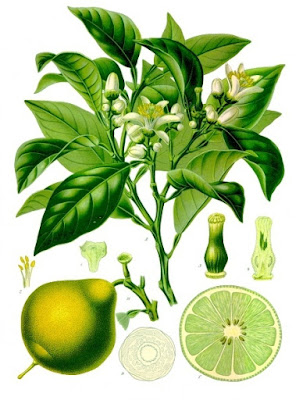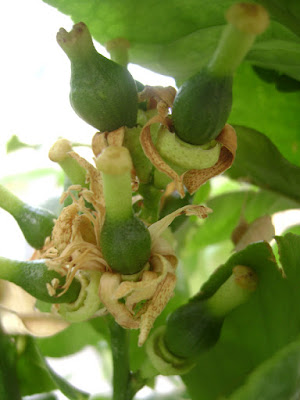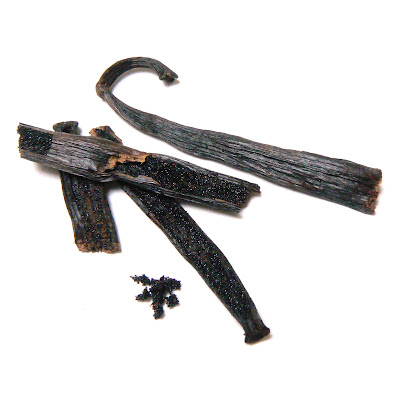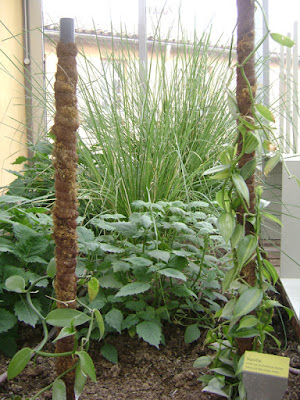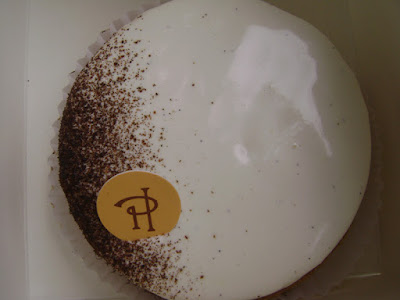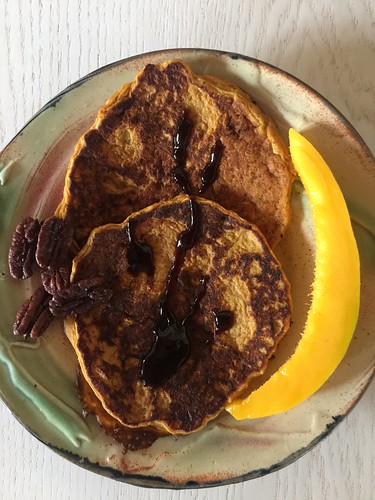Bergamot
Vanilla is the New Silver
True vanilla extract, however, is anything but boring!
Up until the 15th Centruy, vanilla was closely guarded by the Totonac people - first people of Mexico. In the mid 1400s, they were conquered by the Aztec and used vanilla fruits to pay them. The Aztecs adopted "Tlilxochitl"and incorporated it into their ceremonial cacao libation (along with masa harina, chilli and honey). In 1520, Hernán Cortés conquered the Aztecs and was greeted with this beverage. He took with him to Europe many of the botanical treasures he found, including cacao, vanilla beans, tomatoes and chilli peppers. It was not until about 300 years later though, that vanilla would produce any fruit - which happened in one of the French colonies in the Rénunion. But more on that later. 
The name vanilla originates from vainilla - a dimuniative for "vaina" (from the Latin word "vagina", meaning "sheath"). So "a little sheath" because of the shape of the vanilla fruit (or seed pods), which looked like a tiny sheath for placing a sword or a dagger.

Vanillin (4-hydroxy-3-methoxybenzaldehyde) is a perhaps the most important component which gives cured vanilla and its product the characteristic flavor and aroma. Vanillin was first isolated from vanilla pods by Gobley in 1858. By 1874, it had been obtained from glycosides of pine tree sap, temporarily causing a drop in prices of natural vanilla. Vanillin can be easily synthesized from several sources, but most food-grade vanillin (which must be > 99% pure) is made of guaiacol - usually created by the pyrolysis of lignin (a by-product of the paper industry).
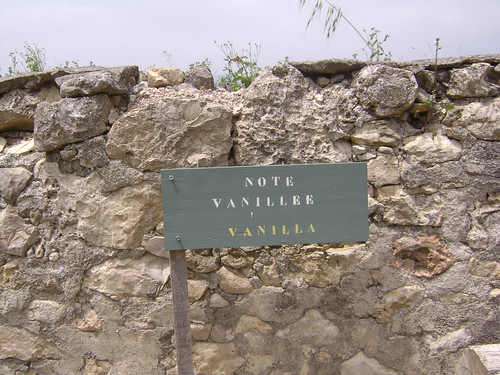
Roles in perfumery: Fits with everything, as long as it’s not overdone - in which case it will dominate! Remember, every time you're adding vanilla, imagine you're adding 5 times the actual amount. Vanilla absolute is a key component in amber bases, ambreine accord, Ambery Orientals, in flavouring tobacco and giving tobacco fragrances their characteristic deep-sweet nuance. In Fougère vanilla absolute proves very useful in smoothing out the rough edges of all the herbaceous notes, and sweetening the bitterness of the oakmoss and coumarin notes.
Perfumery Uses/Blending Tips: Vanilla goes with everything, but in particularly shines when paired with tonka beans, orris butter, leather notes, sandalwood, rose, frankincense, galbanum absolute, labdanum, styrax, bergamot, yang ylang, tuberose, tobacco, mandarin, sweet orange, blood orange, vetiver, oakmoss, patchouli and lavender (so no wonder it’s included in Fougère course).
Pumpkakes
Ensar Oud - First Impressions
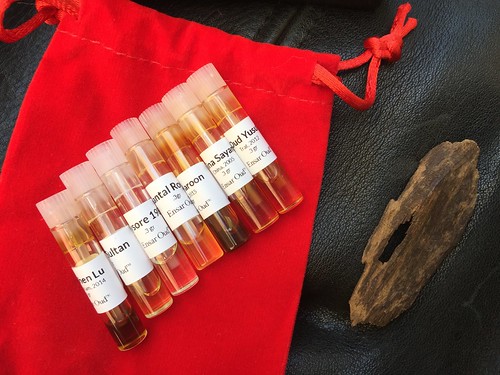
Part of the art of selling single ingredients commodities such as tea lies in the ability of labeling and dating them appropriately with a memorable name. Dealing with oud is no different, with each specimen having a limited supply and very high demand.
Ensar Oud has done an outstanding job in not only sourcing a wide variety of pure oud oils (for wearing neat on the skin, I thought you might ask) and wood (for burning) - but also giving them imaginary names.
Ensar Oud does that with enticing names that make it a lot more memorable than just dates and numbers (although these do have their place and value in recognizing and comparing various aromatic specimens).
Jing Shen Lu
Khao Ra Kam, 2014
Straight from the vial: Notes of spikenard, a tad minty-cool, alongside pungent notes of paint, tar and carbolineum. Reminiscent of antique patchouli as well.
On the skin: Elegant, clean, cool yet also spicy. Vetiver, berry and grass notes - reminiscent of nagramotha and davana mixed together. Tobacco-like with hints of helicrysum also.
Dryout: Woody, sweet yet clean.
China Sayang
China, 2005
Straight from the vial: Musty, old furniture, yet also mellow. Another time it smelled intense animal odours to me - like being surrounded by goats and camels, or sitting in a tent made of goat's hair and sheep's wool, dusty old cow cakes, and visiting caves where the above animals slept in.
On the skin: Grows warmer and sweeter on the skin.
Dryout: Dusty, with the animalic barnyard remnants persist. I happen to be very fond of goats, but find that wearing this on its own is a bit too realistic. I would be curious to blend it in a perfume where it would add a surprising element but only hint to the animals, without smelling so literal.
Oud Haroon
Siam, 2015
Straight from the vial: Funky, animals, valerian, hint of mint, mushroomy (like sour Cepes absolute), Marmite undertones. All in all quite yeasty.
On the skin: Strong yet somehow dull and flat.
Dryout: Becomes cooler woodier as it dries on the skin. Elegant finish to a rather funky beginnings.
Oud Yusuf
Trat, 2012
Straight from the vial: Although it begins with a blow of gasoline fumes notes that brings to mind the rather harsh opening of nagramotha (AKA Cypriol, a type of papyrus with a scent that closely resembles vetiver) - this is the mellowest of the four. Berry-like and smooth-wood body, with dusty clay and dried figs undertones.
On the skin: Clean woody. Hints of roasted nuts and coffee. A tad floral, perhaps even rosy. With herbaceous-grassy undertones, reminiscent of chamomile and blonde tobacco.
Dryout: Warm-woody, a little like vetiver.
After sampling oud oils and woods in various circumstances, I came to the realization that this is one of the most curious, sneaky and fascinating raw materials. It makes a huge difference when, how and where you experience the scents (as burned or warmed wood chips; oils on your skin or on paper or in the vial, etc.). Also, the order in which they are smelled makes a huge impact on their perception. If I were to smell these four ouds in a completely different order, they would smell quite different. I would recommend actually not smelling them side by side but immersing yourself completely in one at a time (which I would do later for each one of the oud oils I have in my collection).
If you decide to warm the oud chips as incense, using the Japanese koh-doh method, try different sequences of the ouds you have. Take lots of notes, not for others to read, but for yourself. It helps a great deal to refine the sense of smell and one's perception, and to pay more attention to the many nuances in these rich and complex treasures. Also this will help you to memorize the very confusing array of ouds available - which may seem useless for a layperson, but if you want to share these treasures with friends and host a little incense party - it will be very helpful to know what you're burning and in which order to place them. It will greatly affect the experience. For example: if a scent is very strong its best to place it last after the more subtle specimens. Also, memorization of what you have will help you enjoy more and be able to better appreciate other ouds that you stumble upon in other places.
Curcuma (Turmeric)

Turmeric (Curcuma longa/C. domestica), also known as Curcuma, Indian Saffron, Indian Yellow Root (not to be focused with American "Yellowroot", which is also sometimes called "Indian Turmeric" but is actually Hydrastis canadensis) or Amomoum Curcuma is a note not often found in Western perfumery, but it has such an important role in herbal medicine (particularly Ayurveda and traditional Chinese medicine), and it's hard to imagine many cuisines without its earthy flavour and bright yellow colour. All in all, turmeric's distinctive aroma is worth exploring on this blog.
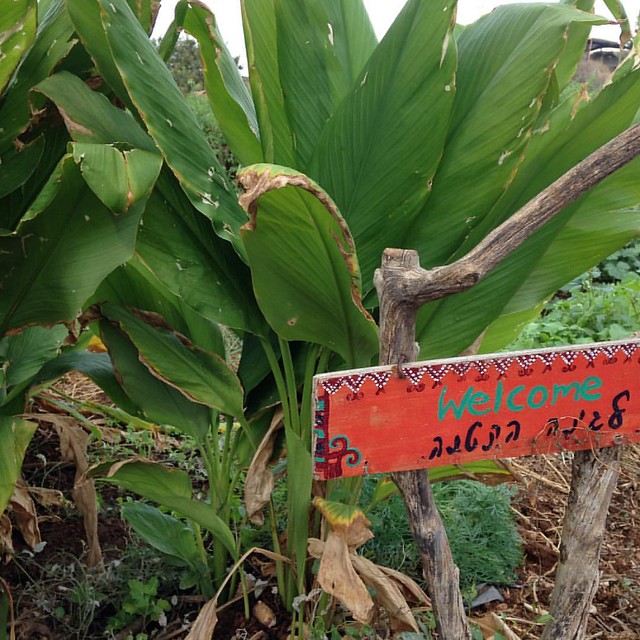
The plant belongs to the ginger, galangal and cardamom family, and like all of these, it has beautiful foliage and showy red-pink flowers that are arranged in an inflorescence, that grow wild in the jungles of Southeast Asia - and where cultivated, can make a garden look lusciously tropical. It can even grow in my home village - although with the nasty eastern winds that blow here many days feel bone dry here and the land is particularly parched this fall, many tropical plants and trees can grow here and produce delicious fruit and fragrant flowers. It does get a bit too cold in the winter, so it may be better for it to grow in a potted plant and be brought into a hothouse during the cooler months (November through March) and of course it will require plenty of watering to make up for the lack of monsoons in our region. I'm certainly going to add it to my little perfumer's botanical garden that I'm dreaming up these days...
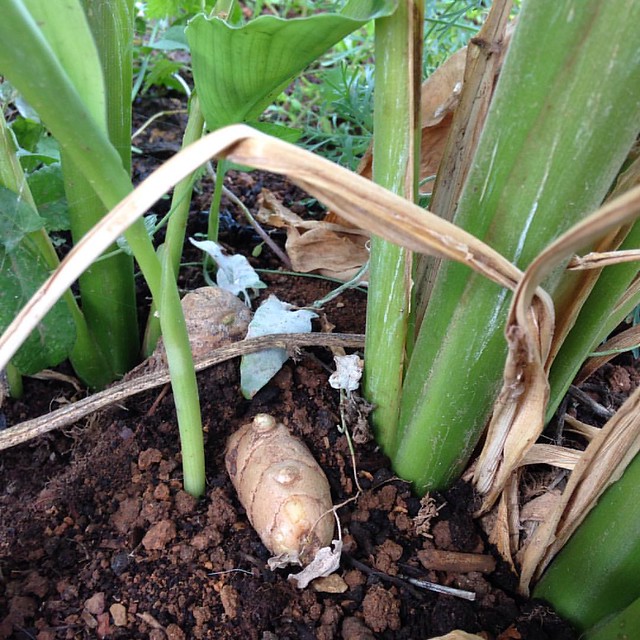
Constituents:
Turmeric is known for its high content of vitamin C and is rich in minerals [1]. It is especially valued for its effective anti-inflammatory properties of its unique constituent curcumin (diferuloylmethane), which also provides its distinctve deep golden-yellow colour. A word of caution: watch out for turmeric that has an orange-red colour (or more of a red hue after coming into contact with liquid) - it is probably adulterated with lead oxide (!), and some turmeric powders are mixed with metanil yellow - AKA acid yellow 36, even though both are toxic and illegal.
Besides curcumin, turmeric contains two other curcuminoids: demethoxycurcumin and bisdemethoxycurcumin, as well as the constituents turmerone, atlantone, and zingiberene, which gives it an earthy, mellow, warm flavour.
Southern Seas Trading Co. in Vancouver sells a turmeric powder that claims to have 5% curcumin, and is really incomparable to the what you'd commonly find on the spice racks in most supermarkets or even in the souks. Too often, turmeric powder has a light yellow, almost sulfur-like colour, and has very little aroma, and taste almost like dust. That is usually a sign that it is probably too old. This is true, by the way, to many spices - if they've lost their vibrancy and "bite", they should be replaced by a fresh batch that has the characteristics you're after. Otherwise - what is the point of adding spices in the first place?!
Turmeric essential oil is clear orange-amber or "a yellowy-orange liquor with a faint blue fluorescence and a fresh spicy-woody odour" [1] with about 60% turmerone, ar-turmerone, atlantone, zingiberone, channel, borneo, sabinene, phellandrene and more. It's important to note that turmerone is a ketone, and is "moderately toxic and irritant in high concentration. Possible sensitization problems". [1]. Becomes semi-viscous over time.
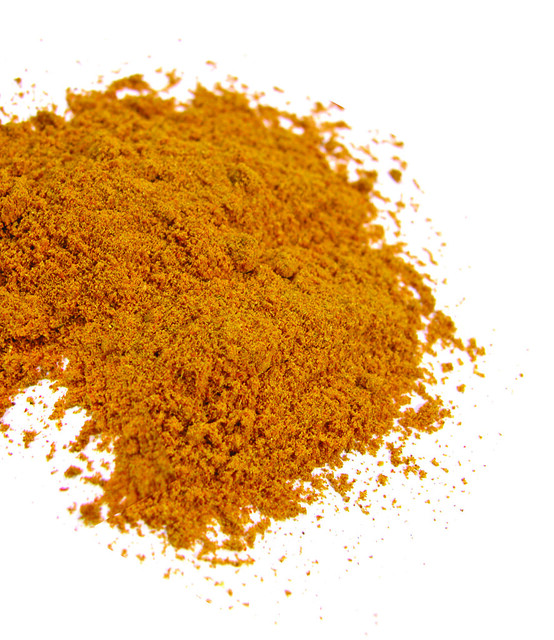
Turmeric as a dye and food colouring:
You've probably ate turmeric without even knowing it in your mustard paste and cucumber pickles (it is used to mask the unsightly fading that is inevitable on pickles that were sitting on the shelf too long). It also gives cauliflower pickles an exotic colour, and brings out the best in mango chutneys and pickles.
Additionally, turmeric can be used as a dye for clothing, although it has very poor lightfast qualities (it fades easily). The saffron-coloured robes that Buddhist monks wear are customarily dyed with turmeric powder. Turmeric is also used in various pastes and unguents that are used in religious rituals to decorate the buddha sculptures and mark the place of the "third eye".
Turmeric in savoury dishes:
In areas where turmeric is a native, fresh leaves are also used to wrap food with and impart their unique flavour to the dish. But in most of the world, it is the dried rhizomes (often referred to as "roots") that are used. In this form, turmeric found its way first through the spice caravans into Arabic cuisine, North Africa and Europe - and later on also to the Americas who in return contributed the heat of chilli peppers to spice blends and cooking traditions the world over.
It's hard to recall many East Indian dishes without turmeric, and indeed you'll find this amount or another in countless East Indian recipes, and in dishes alongside garam masala blends and also in the various blends that are called "curry powder" (mostly these are Western interpretations of various Southeast Asian spice blends) where it is mixed with fenugreek, cumin, coriander seed, and chilli pepper. Other ingredients are used to give it nuances and distinctive style that is usually proprietary, i.e.: dry ginger roots, fennel, cinnamon, cloves, asafoetida, various peppers (long, black...), cardamom (green or black), mustard, and more. Turmeric can be found in other spice blends, such as Ras El Hanout, hawaij (a Yemeni spice mixed usually created with turmeric, cumin, black pepper and cardamom - and in more complex styles also may include cloves, caraway, coriander, fenugreek, etc.).
Turmeric is an essential component of the famous Thai Massaman curry (Muslim-inspired curry), which gives it both its golden colour and mild, earthy note that complements beautifully vegetables such as cauliflower and potato. It is used to colour and flavour banh xao (Vietnamese savoury rice-flour crepes).
Cooking with fresh turmeric is one of the most sensually satisfying culinary encounters, taking off the dusty aspect of working with the ground, dried herb. I was fortunate to procure the mango-coloured root that was at the same exotic produce store I mentioned earlier in Granville Island at the time. The ones I've seen grown in Israel are pale in comparison, but still I recommend experimenting with them. they can be grated as they are to add to curry pastes, or peeled and minced or sliced and be added to stews, soups and even teas. Some swear it is even more effective than ginger in chasing away the season's flu.
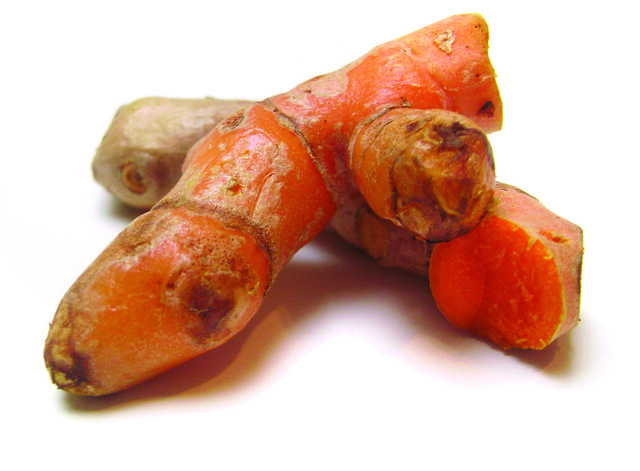
Turmeric in sweets, confections and pastries:
Turmeric leaves are used in preparations of sweets from the west coasts of India called patoleo, patoley or Pan Mori - turmeric-scented cakes of rice and grated coconut. These are offered to several Hindu feminine deities (Parvati, Ganesh) and are eaten in Hindu feasts, India's Independence Day (August 15) and also the Assumption of Mary which falls on the same day and is celebrated by the Catholics in the region.
The Lebanese semolina cake Sfouf has an interesting play on savoury and sweet, and imaginative playful texture. Its fine semolina dough is highly fragrant with powdered turmeric rhizome and incorporates savoury fenugreek seeds and decorated with pine nuts. And if this isn't making you curious yet - it is also layered with tahini (sesame paste) on the bottom and drenched in honey syrup on the top, creating by default a layer of halva at the base.
Another interesting East-Meets-West fusion I've discovered in the souk of Akko, was no other than a very Eastern-European pastry of poppy seed roll, in which the sweet yeast dough was coloured and flavoured with turmeric. After many searches for a poppy seed roll that will satisfy our homesickness (there was a killer poppyseed roll in non other than the seemingly generic Maple Leaf bakery on Davie Street) - this is the closest thing to what we were after, and also great on its own right.
Turmeric in Flavouring Work:
Turmeric essential oil has rather limited use as a favouring agent, because the powder is usually used. Turmeric oil is bitter and slightly pungent, except in extreme dilutions.
The Japanese turmeric has a flavour that is more spicy, bitter and slightly burning.
Turmeric in Folk Medicine:
Turmeric was used by the Jews of India ground turmeric into powder and made a medicinal porridge with sugar to treat diarrhea. Yemeni Jews used curcuma to treat jaundice, headaches stomach aches and digestive complaints. Moroccan Jews made a remedy for jaundice by mixing parts of the plant with honey and consuming it. Persian Jews prepared a paste for massaging the feet by mixing curcuma powder with Arak (an anise liquor). The Jews of Babylon believed that eating dishes heavily seasonsed with curcuma will lift the spirits of anyone who is suffering from depression. [2]
Turmeric in Herbal Medicine and Aromatherapy:
Used for treatment of liver disease, stomach ulcers. For gustatory and digestive disturbances, brew 1 tsp of turmeric powder in boiled water for 5 minutes and sweeten with honey or sugar. For treatment of boils and severe warts, a paste of 50 g of turmeric powder blended with 15 mL (3 Tbs) of olive oil can be spread on the affected area.
Turmeric oil is used to treat inflammatory conditions such as arthritis and rheumatism as well muscular aches and pains. It is also helpful in anorexia, liver convention and sluggish digestion.

Odour Profile:
Earthy, mineral, vibrant, subtle, spicy, fresh, with strong association to baked vegetables and potato and cauliflower curries. Has a certain sourness to it, tangy with hints of sweet orange, ginger and galangal notes. Root-like qualities, with some woody notes and slightly green note (this aspect has reminiscence to the sesame plant).
Japanese turmeric oil is more warm, dry-woody, powdery, camphoreous and with a slightly pepper-spicy note that brings to mind Atlas cedar wood [3].
Turmeric in Perfumery:
Turmeric is an exotic and unusual note that can be used in Oriental fragrances and imaginative Chypre fragrances. It works particularly well with Atlas cedar wood, rose, tuberose, ylang ylang, elecampane, violet, sandalwood, labdanum, orris resin, clary sage, mimosa, cassie, ginger, galangal, ginger lily, saffron and other spices, as well as ionones, musks, heliotropine, etc [3]
As mentioned earlier, the use of turmeric is rather limited. Aside from my own work with it, I can't recall smelling it in too many perfumes, and I can only guess it may be a note in Santal de Mysore, as well as some natural perfumes I've experienced such as the now defunct Rose by Scent Systems and Aftelier's Parfum de Maroc. I've incorporated it in successfully in my "Massaman Curry" accord, which I've used in Tuberose Massaman OOAK perfume. There is also a hint of turmeric in another OOAK perfume titled "Curry Rose". I got to admit it worked well with these florals, echoing the buttery mystery of tuberose that is underlined but tuberous moistness; and also giving an earthiness for the rose to grow on.
Some of you may have also experienced some of my trials for an oud perfume that includes copious amounts of it - Assam Oud. In the latter, I've been greatly struggling with finding the balance between the elements, and the turmeric seemed to create a problem - constantly bringing out a sourness from the tagetes (marigold) which I was not fond of. It was a frustrating experience, but not one I am giving up on. There will be an Assam Oud perfume eventually for more of you to enjoy, and I am determined to find a way for the turmeric to work in there. There simply is something haunting and earthy about turmeric that I really want to mingle with agarwood's musty earthiness.
[1] Lawless, Julia, "The Encyclopedia of Essential Oils", Elements Books, Australia, 1992, pp. 182-183
[2] Krispil, Nissim "Medicinal Plants in Israel and Throughout The World - The Complete Guide", Hed Artzi, Or Yehuda, Israel 2000, p. 132.
[3] Arctander, Steffen, "Perfume and Flavour Materials of Natural Origin", Allured Publishing, 1994, pp. 203-205
- Previous
- Page 1 of 3
- Next
- Previous
- Page 1 of 3
- Next


